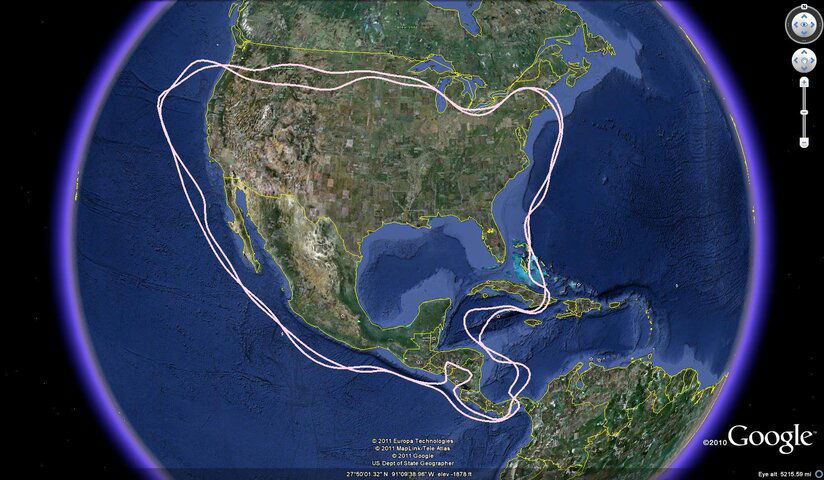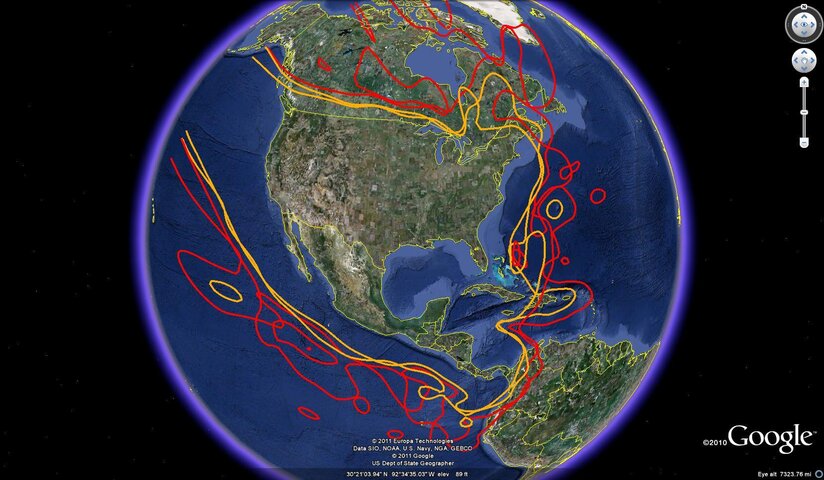Quetzsat 1 Successfully Launched!
- Thread starter nelson61
- Start date
- Latest activity Latest activity:
- Replies 321
- Views 56K
You are using an out of date browser. It may not display this or other websites correctly.
You should upgrade or use an alternative browser.
You should upgrade or use an alternative browser.
If things go as scheduled, it will start testing at 67.1W on Oct 11. Give them a couple weeks to check it out and then another couple to move it on to 77W.
So, a fair guess would start around mid November. Could take less time, could take more time.
Echostar filed yesterday with FCC for broadcast service beginning as early as October 30. Does not necessarily mean they will be ready but want operational licenses active by that date.
For those that do not need the specific dBw curves shown on Satelliteguys SatMaps.
The service area photo encloses the area expected to receive Quetzsat 1 using a "standard" Dish antenna.
The large antenna photo shows the reception area using antennas up to 6 or 8 feet in diameter.
Again, the satellite has two beams, East and West, the only significant difference being the East beam can be received in Bahamas and Puerto Rico/Virgin Islands with a large antenna.
The service area photo encloses the area expected to receive Quetzsat 1 using a "standard" Dish antenna.
The large antenna photo shows the reception area using antennas up to 6 or 8 feet in diameter.
Again, the satellite has two beams, East and West, the only significant difference being the East beam can be received in Bahamas and Puerto Rico/Virgin Islands with a large antenna.
Attachments
Looks like I might have trouble getting here in Connecticut... not good for a Eastern Arc satellite.
Looks like I couldn't get it here in Michigan either.
Sent from my iPad 2 using the SatelliteGuys App
Sent from my iPad 2 using the SatelliteGuys App
For those that do not need the specific dBw curves shown on Satelliteguys SatMaps.
The service area photo encloses the area expected to receive Quetzsat 1 using a "standard" Dish antenna.
The large antenna photo shows the reception area using antennas up to 6 or 8 feet in diameter.
Again, the satellite has two beams, East and West, the only significant difference being the East beam can be received in Bahamas and Puerto Rico/Virgin Islands with a large antenna.
If you are wondering why the QuetzSat-1 satellite was designed this way it is because of possible interference with the Canadian DBS slot at 82 W. 77 W is a Mexican licensed DBS slot. Obviously Dish can't use the QuetzSat-1 satellite for national programming for the Eastern Arc so it is expected that it will be used for some locals. Dish has use of 24 TPs in the U.S. but because of the dual polarity design, Dish effectively can use 48 TPs in the U.S. This is a lot less capacity than what a today's typical spotbeam satellite can provide but it is more than what Dish is currently using at 77 W.
Looks like it may be a big help to those in PR for getting programming on the E beam though the will have to have good size ant.
Schedule is proceeding with no apparant problems.
At the BaikonurCosmodrome continued to prepare for the launch of space rocket (ILV),"Proton-M" with the upper block (RB) "Breeze-M" and thetelecommunications spacecraft (SC) "KvettsSat-1".Today experts rocket andspace industry are working on the program of the third launch day. In the morning at thelaunch site a meeting of technical guidance on the test results of space rocketsystems and simulate the filling of the launch vehicle.At the launch complexSq. 200 specialists of Russian Space Agency conducting temperature control theascent of RKN, is onboard charging batteries of the spacecraft.Also today, will beperformed Docking storage and drainage connections to the neck of the booster.Work on the launchcomplex will continue until late evening.Start ILV"Proton-M" with RB "Breeze-M" and SC"KvettsSat-1" is scheduled for September 29.Press Service of theRussian Space Agency
At the BaikonurCosmodrome continued to prepare for the launch of space rocket (ILV),"Proton-M" with the upper block (RB) "Breeze-M" and thetelecommunications spacecraft (SC) "KvettsSat-1".Today experts rocket andspace industry are working on the program of the third launch day. In the morning at thelaunch site a meeting of technical guidance on the test results of space rocketsystems and simulate the filling of the launch vehicle.At the launch complexSq. 200 specialists of Russian Space Agency conducting temperature control theascent of RKN, is onboard charging batteries of the spacecraft.Also today, will beperformed Docking storage and drainage connections to the neck of the booster.Work on the launchcomplex will continue until late evening.Start ILV"Proton-M" with RB "Breeze-M" and SC"KvettsSat-1" is scheduled for September 29.Press Service of theRussian Space Agency
Once I asked
Then nelson replied
But then again...
I still can't understand this. What's the real advantage? the two beam maps look very, very similar, so what's the point of having two beams?
the mexican service with 8 transponders will count with twice the capacity which it has today?
Then nelson replied
E8 has 32 operating transponders. Quetzsat the same so no chamge there.
The only absolute change is the area covered by the beams
But then again...
Dish has use of 24 TPs in the U.S. but because of the dual polarity design, Dish effectively can use 48 TPs in the U.S. This is a lot less capacity than what a today's typical spotbeam satellite can provide but it is more than what Dish is currently using at 77 W.
I still can't understand this. What's the real advantage? the two beam maps look very, very similar, so what's the point of having two beams?
Found this:
"The launch of the Proton-M carrier rocket with QuetzSat-1 satellite has been scheduled for Thursday at 22:32 Moscow time [18:32 GMT]. The separation of the satellite from the carrier rocket has been slated for Friday at 7:45 Moscow time [3:45 GMT]," the spokesman said.
So it'll be around 2:32pm EST Russia set for launch of Proton-M carrier rocket with Mexican satellite | Science | RIA Novosti
Edit: Nelson and I posted at the same time.
"The launch of the Proton-M carrier rocket with QuetzSat-1 satellite has been scheduled for Thursday at 22:32 Moscow time [18:32 GMT]. The separation of the satellite from the carrier rocket has been slated for Friday at 7:45 Moscow time [3:45 GMT]," the spokesman said.
So it'll be around 2:32pm EST Russia set for launch of Proton-M carrier rocket with Mexican satellite | Science | RIA Novosti
Edit: Nelson and I posted at the same time.
Do we have any more up to date launch times?
Today, both SES and ILS confirmed the previously posted launch times 2:32 PM Eastern Time
Media Advisory | QuetzSat-1 | Proton Rocket | Commercial Launch | International Launch Services
I am attaching an excel file that can be use to track the event timelines (from the launch profile).
In the event there is a delay, changing the Mountain Daylight Time launch time (yellow) will correct all times in the 4 time zones.
Attachments
simonhwsn said:Once I asked
Then nelson replied
But then again...
I still can't understand this. What's the real advantage? the two beam maps look very, very similar, so what's the point of having two beams?
Good question with no answer (yet). Maybe one Mexico and the other US, maybe so it can be used at another slot (although they are really similar), maybe sething else.
Tune in on Dishnetwork Channel 101 at 2:15 PM Eastern for live broadcast
Internet live broadcast at: http://quetzsat1.imgondemand.com%20/
Internet live broadcast at: http://quetzsat1.imgondemand.com%20/
International Launch Services has activated their countdown clock.
Proton Rocket | Commercial Launch | Sales & Mission Management
Proton Rocket | Commercial Launch | Sales & Mission Management
post #3 77W to Replace Echostar 8What satellite is this replacing or is a new location? ty for help and reply



